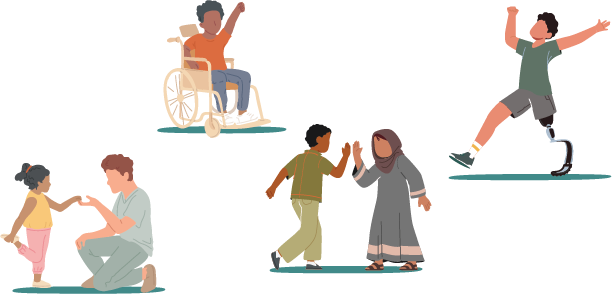Our goal
We want every family to get what their child needs so that they can play, go to school, and grow up to become a healthy adult. We want parents and siblings to thrive too.
F2F Health Information Centers improve the lives of children and youth with special health care needs. They provide services to more than 200,000 families and 100,000 health professionals each year.
We want every family to get what their child needs so that they can play, go to school, and grow up to become a healthy adult. We want parents and siblings to thrive too.

People who staff these centers have the personal experience (or “lived experience”) to help families navigate complex—often disparate—challenges related to health, education, and social services. The staff are trusted sources of information and support in stressful times.
New These stories depict the value of F2F peer support:
As our Blueprint for Change: A National Framework for a System of Services for Children and Youth with Special Health Care Needs explains, family voices can help improve the social and health care systems. Peer counselors teach and prepare parents to engage with these systems effectively. In the process, parents become leaders who help bring positive change.
These centers also teach and engage providers to respond to and partner with families. When family voices are the focus, everything improves: health care quality, access, fairness, and financing.
These services work with families as both providers and clients. According to previous surveys, actively engaging families as equal partners in their child’s health care and decision-making leads to:
The centers help by:
Navigating insurance benefits and ever-changing policies. For example, helping families:
Centers also help programs and providers understand how to pay families while they care for their children. This helps address existing shortages in the workforce.
Building leadership, advocacy, and communication skills. For example, helping a family:
Connecting to peer and emotional support. For example, providing an F2F support specialist who has similar challenges, or connecting to a family with similar circumstances.
Finding condition-specific information and services. For example, sharing information and resources about how to modify a person’s home for safety and accessibility.
Developing school-based health care plans for a child. For example, partnering with parents to help get them referrals and plans in place for the school services their child needs.
Congress funded this program in 2005 and expanded the work in 2018. Today, the program is in all 50 states, Washington D.C., 5 territories, and 3 tribal communities.
Congress must reauthorize the program in 2024 for its activities to continue.
To learn more and find a center in your state, go to What Are F2Fs?